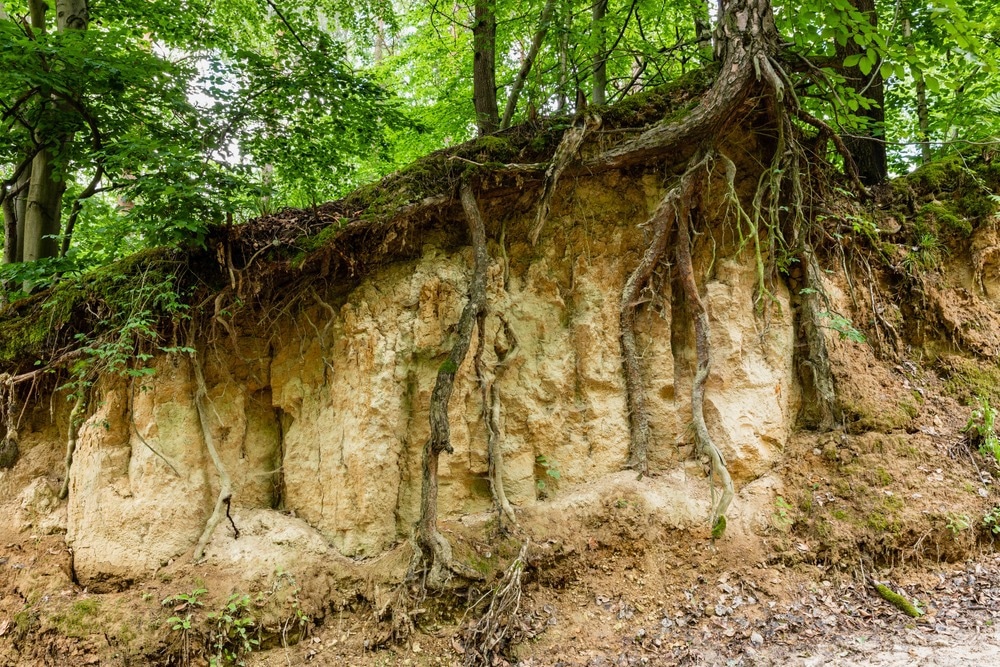In an article published in the journal Soil and Tillage Research, researchers carried out a series of constant-shear drained (CSD) triaxial tests on Q2 loess (silt loam, a loose aeolian deposit) in the South Jingyang Platform of China to better understand the mechanical failure process and properties of soil under the different rate of increase in pore water pressure RIPWPs.

Study: Mechanical and microscopic properties of soil according to the rate of increase in pore water pressure. Image Credit: Fotema/Shutterstock.com
What is Loess Soil?
Loess soil, comprised of yellowish silt-sized aeolian deposits during the Quaternary era, is extensively dispersed in China, notably in the middle reaches of the Yellow River, in which loess soil erosion is a prevalent concern.
Loess soil spans an area of around 63.5 × 104 km2, which is comparable to 6.6% of the entire land area of China.
Large porosity and lack of cementation are structural features of natural loess, which may cause sudden collapses and a loss of strength when exposed to water.
Soil Erosion in China and its Effects
In dry parts of western China, the increasing groundwater level brought on by agricultural irrigation has recently produced continuous soil erosion, resulting in many slope slides in the loess platform.
These slides have hindered the natural environment's and agriculture's ability to grow sustainably by causing substantial soil erosion and the ongoing loss of cultivated area. Therefore, a fundamental to understanding the mechanism of slope instability and successfully preventing soil erosion is to elucidate the impacts of increasing groundwater levels on soil deformation and failure processes.
Previous Studies
The pore water pressure in loess constantly rises as the groundwater table rises, yet its deviatoric stress stays constant, and its effective mean stress declines, which may quickly result in instability.
Researchers suggested continual shear drained testing to simulate the stress states loess. By raising the pore water pressure while the deviatoric stress is constant, loess may alter its effective stress state, which leads to liquefaction.
Using constant-shear drained (CSD) triaxial tests, several researchers have investigated the stress-strain characteristics and instability mechanisms of saturated loess throughout pore water pressure increase. It has been suggested that increases in pore water pressure, which generate undrained shear, are the primary cause of liquefaction. Different rates of groundwater table rise cause variations in the rate of increase in pore water pressure (RIPWP), which significantly influences the stress routes and failure modes for loess.
Microscopic analysis is one of the most popular techniques for researching soil instability processes in the geotechnical area. The liquefaction behavior of loess under shear or vibration conditions is often studied using scanning electron microscopy (SEM).
Using SEM and CSD for Soil Analysis
The RIPWP significantly impacts soil deformation and failure processes under continuous deviatoric stress. However, its effects on soil's mechanical behavior and microstructure are unknown.
This study used SEM and CSD triaxial tests to clarify the microscopic properties of soil with a constant deviatoric stress path, revealing the microscopic parameters of loess liquefaction with a constant deviatoric stress path, and study the mechanical properties of soil samples under different RIPWPs.
The study's findings serve as guidelines for soil erosion management on the loess platform's agricultural irrigation area.
The South Jingyang Platform, Shaanxi Province, Lishi (Q2, depth of about 25 m below the ground surface) loess provided the samples for the tests. Some of the loess soil's fundamental physical characteristics were identified using pertinent ASTM (American Society for Testing and Materials) standard test procedures.
The natural density, water content, specific gravity, void ratio, and permeability coefficient are some characteristics of loess soil. An SLB-1A stress-strain controlled triaxial equipment was used to conduct CSD triaxial testing, whereas SEM was used to examine the samples' microstructures.
Significant Findings of the Study
The deformation and failure processes of the samples may be split into two phases with increases in back pressure: steady creep and severely unstable deformation. Stress redistribution and particle interlocking are thought to be the causes of the emergence of rapid-slow strain growth states at low shear rates of 2–20 kPa/h. The samples' critical pore pressure ratios ranged from 0.48 to 0.66. As the shear rate rose, the samples took less time to achieve a liquefaction condition.
The samples had a higher number of macropores and mesopores before the CSD triaxial testing. Point-point and point-edge contacts were the most common types of contacts between particles. There were clear aggregation structures after the experiments. The number of macropores significantly decreased, the number of inter-particle micropores significantly increased, and there were more indications that clay particles were dispersed and migrated to fill the pores. Additionally, there were declines in pore abundance and fractal dimension and a propensity for the particles and pores to adopt evident orientations.
The major microscopic cause of the samples' instability was the persistent rises in pore water pressure, which caused the clay cements to liquefy, disseminate, and slide into pore throat channels, creating local obstructions and alterations to the original seepage channels. The samples' local pore water pressure differential increased as a result. The activities of pore water pressure and continual shear stress caused local liquefaction of saturated soil samples when the samples reached their critical failure states.
Reference
Zhao Duan, Zhen-Yan Li, Yan-Bin Wu, Bing Niu, Rong-Jian Shen (2023) Mechanical and microscopic properties of soil according to the rate of increase in pore water pressure. Soil and Tillage Research. https://www.sciencedirect.com/science/article/pii/S0167198722002161
Disclaimer: The views expressed here are those of the author expressed in their private capacity and do not necessarily represent the views of AZoM.com Limited T/A AZoNetwork the owner and operator of this website. This disclaimer forms part of the Terms and conditions of use of this website.